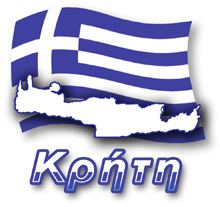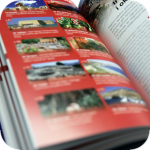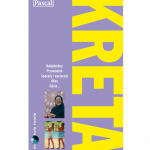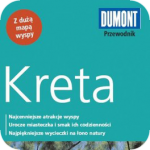
 Below we present you a review of this year's publishing news, which came to the bookstore in March 2014. The Navigator Guide from the Navigator series is relatively cheap and will not deplete your portfolio too much. For about PLN 20 you will get a well-published small book that has been printed on thick paper of good quality. At the first contact, the price set by the SBM publishing house may seem a bit undervalued in relation to the received product (especially comparing it to other competing editions). After a few minutes of a cursory browsing of this guide, it is possible to notice what the greatest savings have been made to obtain such an attractive price.
Below we present you a review of this year's publishing news, which came to the bookstore in March 2014. The Navigator Guide from the Navigator series is relatively cheap and will not deplete your portfolio too much. For about PLN 20 you will get a well-published small book that has been printed on thick paper of good quality. At the first contact, the price set by the SBM publishing house may seem a bit undervalued in relation to the received product (especially comparing it to other competing editions). After a few minutes of a cursory browsing of this guide, it is possible to notice what the greatest savings have been made to obtain such an attractive price.
Unfortunately, the "intuitive maps" highlighted on the cover are in fact very schematic plans that, apart from poor reproduction, are also very economical in details. The usefulness of these maps in our opinion is rather small and certainly they will not be too helpful while exploring Crete by car or even more during hiking. The only sensible function of these plans is that they make it easier to find places described in the guide on another "serious" cartographic product.
Another aspect on which the publisher decided to save is the photographs used in the guide. The vast majority of images that are illustrations of texts are materials made available under CC (Creative Commons) license acquired from Wikipedia and other popular websites. Some of the photographs used are, however, made available under the CC BY-NC license (non-commercial use), so the appearance of them in the guide is a bit strange. This feature should not be perceived as a defect lowering the value of this guide, but as lovers of Crete and the fascinates of photography, we always attach importance to using our own images illustrating the articles. We like it when others use similar practices and we always try to appreciate it.
Let's leave the maps and photos and go to the content of this guide, which is its greatest value. At the outset, it is worth noting that this publication is not an anonymous collective study. This is another guide available on our market, which is assigned to one author, Ms. Malwina Łukomska. The individual authorship of the guide usually translates to good quality of the descriptions of places and interesting suggestions of the trips that were added. The texts of such a publication are based on the author's personal experience and are supported by verified knowledge obtained from other sources. I must admit that the guide of Crete's SBM publishing house is not a little disappointing in this respect. What's more, the texts prepared by Ms. Malwina Łukomska are written in a very accessible language, so we were happy to come back to reading this guide.

Każdy rozdział poprzedzony jest stroną z listą dziesięciu najważniejszych atrakcji danego rejonu Krety
The content devoted to exploring Crete has been divided into four chapters according to the administrative division of the island. Each part begins with a list of the ten most important places in a given nomata of Crete. The described trips are, in our opinion, interesting and well planned. In addition to the typical routes that the vast majority of people visiting Crete enjoy, there are also a few proposals that break these tourist schemes. Those interested in active tourism and trekking will certainly be delighted with the descriptions of some rather demanding hiking tours. Among the proposals included in this guide, it is worth mentioning such trips as following the route along the Megapotamos river flowing through the Kouartaliotiko gorge, crossing the E4 route near the southern coast of Crete, or getting one of the summits of the Asterousia mountain massif.
A certain inconvenience associated with the use of this guide may be the fact that Ms. Malwina, using descriptions of some places and monuments, operates not always popular single equivalents of Greek names. For some people, this can make it difficult to find additional information found in other guides or the internet. Not every person using the guide will be familiar enough with Crete to combine the name Porta Guora with the characteristic monument of Rethymnon - Megali Porta, or the name Tzagarolon with the very recognizable Cretan monastery Agia Triada. This inconvenience, however, is a small detail that does not affect the overall positive assessment of the content of this guide.
The quality of the texts by Malwina Łukomska puts the shortcomings of the issue we pointed out at the beginning of the review into the background. Low price is another advantage of this release. In our opinion, this pocket edition from the Navigator series will be a perfect complement to encyclopedic guides such as the "Crete" Baedeker publishing house. Recommended.

Maps are by far the weakest element of this guide

Pascal's Guide to Crete from 2006 (with resumption in 2009) belongs to the series of guides around the world, which are characterized by a small format (24 x 11 cm), a soft spiral binding and a colorful cover with a large, vertical name of the described place. This graphic design makes these guides easily recognized on the shelf in the bookstore. The Crete Guide is a collective study translated from English with 192 pages. The book was printed on glossy, chalk paper, which kept the image quality high.

The Discovery Channel guide published by the RM Publishers in 2007 is a 120-page translation of the English collective study. The main author of the texts is Brigitte Seckendorff-Kourgierakis, who, while working on this guide, crossed Crete along the breadth.

The Dumont booklet from Crete (in Poland printed by PWN) is another very handy pocket publication that is sold at a reasonable price of less than PLN 20. Despite its small size, Klaus Bötig, who is the author of this guide, managed to put quite a lot of interesting information in this position.
Komentarze
Wypełnij poniższy formularz aby dodać komentarz